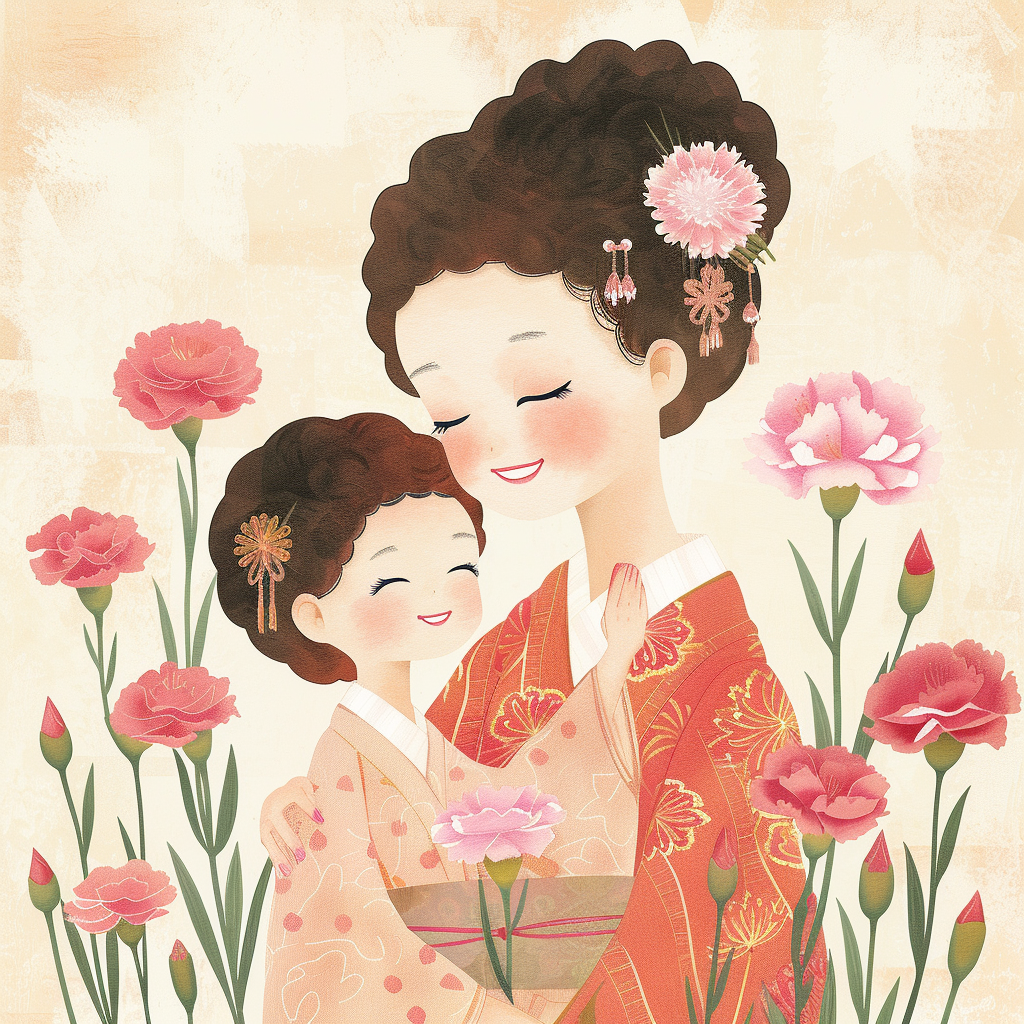
Carnations Honor Mothers in Japan on May 12, 2024
Mother’s Day in Japan falls on May 12th in 2024. The holiday originated in the United States in the early 1900s and was later adopted in Japan. On this day, people express gratitude to their mothers, often giving carnations which symbolize a mother’s love. It has become an important occasion to recognize and appreciate the significant role mothers play in families and society. (55語)
日本語訳
「2024年5月12日、カーネーションで日本の母を称える」
2024年の日本の母の日は5月12日に当たる。この祝日は1900年代初頭にアメリカで始まり、後に日本でも取り入れられた。この日、人々は母親への感謝を表し、母の愛を象徴するカーネーションを贈ることが多い。家族と社会における母親の重要な役割を認識し、感謝する大切な機会となっている。

単語・熟語チェック
・honor 称える、敬意を表する
・originate 発祥する、起源を持つ
・adopt 採用する、取り入れる
・express 表す、表現する
・gratitude 感謝
・symbolize 象徴する
・recognize 認識する、認める
・appreciate 感謝する、認める
・significant 重要な、意義深い
・role 役割
単語解説
・honor
⇒称える、敬意を表するという意味の動詞。名詞形のhonorは「名誉」「栄誉」「敬意」などの意味。母の日に母親を称え、敬意を払うという文脈で使われています。honorの語源はラテン語のhonor(名誉)で、honorableやhonorary などの関連語があります。
・originate
⇒発祥する、起源を持つという意味の動詞。originが名詞で「起源」「由来」という意味。母の日がアメリカで始まったことを表現しています。同じ語源のoriginは「原点」「起源」、originalは「独創的な」「オリジナルの」などの意味があります。
・adopt
⇒採用する、取り入れるという意味の動詞。アメリカ発祥の母の日を日本が取り入れたことを表現。adoptには「養子にする」という意味もあり、adoptionが「採用」「養子縁組」などの意味の名詞です。類語にacceptやembraceがあります。
・symbolize
⇒象徴するという意味の動詞。symbolが名詞で「象徴」「シンボル」という意味。カーネーションが母の愛を象徴することを表現。-ize (-ise) は動詞を作る接尾辞で、「~化する」「~のようにする」などの意味を加えます。
・significant
⇒重要な、意義深いという意味の形容詞。significanceが名詞形で「重要性」「意義」という意味。母親の役割の重要性を強調するのに使われています。signは「兆候」「印」などの意味があり、significantは文字通り「意味のある」というニュアンスです。
原ちゃんチェック
母の日は感謝を伝える大切な機会ですね。普段は照れくさくて言葉にできない分、この日ばかりは素直に「ありがとう」と伝えたいものです。
カーネーションを贈る習慣は、アメリカ発祥とはいえ、今や日本の母の日に欠かせないものとなりました。花言葉が「母の愛」というのもぴったりです。カーネーションの語源はギリシャ語の「花の神」を意味するDianthusだそうで、母を神に例えているのかもしれません。
最近では定番のカーネーション以外に、母の好みに合わせて様々なプレゼントを贈る人も増えているようです。でも何を贈るにせよ、日頃の感謝の気持ちを込めることが何より大切だと思います。家事や育児など、目に見えない母の貢献にもっと光を当てていく社会になってほしいですね。
母の日をきっかけに、家族のきずなを再確認する。そんな温かい一日になりますように。
関連URL
原田英語深堀りチェック
【The Origins and History of Mother’s Day】授業プリント
Mother’s Day is a special occasion celebrated in many countries around the world to honor mothers and show appreciation for their love, care, and sacrifices. The modern version of Mother’s Day began in the United States in the early 20th century.
In 1908, Anna Jarvis from West Virginia organized the first Mother’s Day celebration in memory of her own mother. She wanted to create a day to honor all mothers because she believed they were “the person who has done more for you than anyone in the world.” Jarvis started a campaign to make Mother’s Day a recognized holiday, and in 1914, President Woodrow Wilson officially declared the second Sunday in May as Mother’s Day.
The celebration of Mother’s Day quickly spread to other countries. In the United Kingdom, Mothering Sunday has been celebrated on the fourth Sunday of Lent since the 16th century. Initially, it was a day for people to visit their “mother church,” but over time, it became a day to honor mothers.
In Japan, Mother’s Day was introduced in 1913 and is celebrated on the second Sunday of May, just like in the United States. In France, Mother’s Day is celebrated on the last Sunday of May, unless it coincides with Pentecost Day, in which case it is moved to the first Sunday of June.
While the dates and traditions may vary, the sentiment behind Mother’s Day remains the same: to celebrate and appreciate the important role mothers play in our lives. (Word count: 247 words)
1. When did the modern version of Mother’s Day begin in the United States?
a) In the late 19th century b) In the early 20th century
c) In the mid-20th century d) In the late 20th century
2. Who organized the first Mother’s Day celebration in the United States?
a) President Woodrow Wilson b) Anna Jarvis
c) A group of mothers d) A religious organization
3. In the United Kingdom, Mothering Sunday was initially a day for people to:
a) Visit their “mother church” b) Honor their mothers
c) Celebrate Pentecost Day d) Visit their grandmothers
4. In France, Mother’s Day is celebrated on:
a) The second Sunday of May b) The last Sunday of May, unless it coincides with Pentecost Day
c) The first Sunday of June d) The fourth Sunday of Lent
Answers:
1. b) The modern version of Mother’s Day began in the United States in the early 20th century.
2. b) Anna Jarvis from West Virginia organized the first Mother’s Day celebration in the United States.
3. a) Initially, Mothering Sunday in the United Kingdom was a day for people to visit their “mother church.”
4. b) In France, Mother’s Day is celebrated on the last Sunday of May, unless it coincides with Pentecost Day, in which case it is moved to the first Sunday of June.
日本語全訳:
母の日の起源と歴史
母の日は、世界の多くの国々で祝われる特別な日で、母親を称え、その愛情、ケア、そして犠牲に感謝を示すためのものです。現代版の母の日は、20世紀初頭にアメリカ合衆国で始まりました。
1908年、ウェストバージニア州のアンナ・ジャービスは、自身の母を偲んで最初の母の日のお祝いを開催しました。彼女は、母親は「世界で誰よりもあなたのためにたくさんのことをしてくれた人」だと信じていたため、すべての母親を称える日を作りたいと考えました。ジャービスは母の日を公認の祝日にするためのキャンペーンを開始し、1914年、ウッドロー・ウィルソン大統領が5月の第2日曜日を母の日と正式に宣言しました。
母の日の祝賀は、他の国々にも急速に広がりました。イギリスでは、16世紀以来、四旬節の第4日曜日に「母の日」が祝われてきました。当初は、人々が「母なる教会」を訪れる日でしたが、時代とともに母親を称える日になりました。
日本では、1913年に母の日が導入され、アメリカと同じく5月の第2日曜日に祝われています。フランスでは、母の日は5月の最終日曜日に祝われますが、聖霊降臨祭と重なる場合は6月の第1日曜日に移動します。
日付や伝統は異なるかもしれませんが、母の日の背景にある感情は同じです。それは、私たちの人生において母親が果たす重要な役割を祝い、感謝することです。






